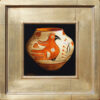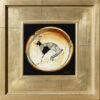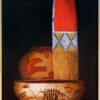Born in 1935, Arizona-based still-life painter,
Chuck Sabatino, has long studied and collected the historic and prehistoric Southwest pueblo pottery he has become so well known for painting.
Chuck Sabatino was born in 1935 in Bronx, New York. An avid painter by the time he was in high school, and then became interested in advertising. He attended the Cartoon & Illustrator School in New York which later became the School of Visual Arts. For the 25 years that followed, he painted consistently in his free-time while he worked in New York City as an art director and T.V. producer creating countless ads and commercials for companies including American Motors, Johnson & Johnson and Proctor & Gamble. Not only did his commercial work during this time earn him 24 awards, it also exposed him to the Southwest through travel where he became very interested in Native American Art and History. Upon retiring in 1988, he and his wife Millie moved to the home they had built in Scottsdale, Arizona where Sabatino turned his full attention to his painting.Sabatino’s works are meticulously detailed renditions of his beautifully composed still-lifes in rich warm hues. He paints the pottery of the Zuni, Acoma, Santo Domingo, Cochiti, San Ildefonzo and Santa Clara often arranged alongside beaded moccasins, arrow bags, dresses, flowers, the photos of E. S. Curtis and other paper works. His combinations create a multiplicity in texture and color, and represent a range of visual and historical interests.Sabatino’s work has been featured in books and such publications as Southwest Art and Art of the West. His pieces have been displayed at Leanin’ Tree Museum of Western Art and adorn a growing number of private collections internationally.

1870_wasco_beaded_dress_and_pueblo _pottery_frame
1870 Wasco Beaded Dress and Pueblo Pottery
72" x 48" • Oil • $35,000
paraphernalia_of_a_sioux_warrior_aotw
Paraphernalia of a Sioux Warrior
46" x 30" • Oil • $12,500
sioux_horse_stick_frame
Sioux Horse Stick
48" x 24" • Oil • $11,500
canyon_de_chelly_and_casa_blanca_lillies_aotw
Canyon de Chelly and Casa Blanca Lillies
30" x 48" • Oil • $13,200
canyon_de_chelly_&_otto_moccasins_framed
Canyon de Chelly & Otto Moccasins
25" x 32" • Oil • $9,500
a_gray_day_in_the_badlands_framed
A Gray Day in the Badlands
30" x 24" • Oil • $9,000
cow_skin_beaded_storage_bag_framed
Cow Skin Beaded Storage Bag
24" x 30" • Oil • $9,000
1880_sioux_flat_case
1830 Sioux Storage Bag
24" x 30" • Oil • $9,000
cheyenne_dog_soldiers_shirt_1860_frame
Cheyenne Dog Soldiers Shirt
30" x 48" • Oil • $13,200
1890_lakota_sioux_ghost_dance_dress_frame
1890 Lakota Sioux Ghost Dance Dress
48" x 34" • Oil • $15,000
1885_cheyenne_beaded_dress_frame
1885 Cheyenne Beaded Dress
48" x 30" • Oil • $13,200
1890_arapaho_ghost_dance_dress_II-frame
1890 Arapaho Ghost Dance Dress II
48" x 30" • Oil • $13,200
lakota_sioux_or_arapaho_ghost_dance_dress_frame
Lakota Sioux or Arapaho Ghost Dance Dress
48" x 30" • Oil • $13,200
central_plains_saddlebag_frame
Central Plains Saddlebag
36" x 16" • Oil • $9,200
sioux_saddlebags_frame
Sioux Saddlebags
20" x 10" • Oil • $3,800
1865_oto_tabacco_bag_frame
1865 Oto Tobacco Bag
36" x 10" • Oil * $8,000
cheyenne_tabacco_bag_frame
Cheyenne Tobacco Bag
36" x 10" • Oil • $8,000
1885_crow_tobacco_bag_frame
1885 Crow Tobacco Bag
36" x 10" • Oil • $8,000
plains_tobacco_bag_and_pipe_2021
Plains Tobacco Bag and Pipe
30" x 12" • Oil • $5,500
plains_tobacco_bag_and_pipe
Plains Tobacco Bag and Pipe
30" x 12" • Oil • $5,500
1880s_cheyenne_bow_and_arrow_case_frame
1880's Cheyenne Bow & Arrow Case
10" x 36" • Oil • $8,000
kiowa_cheyenne_plains_pouches_frame
Kiowa, Cheyenn, Plains Pouches
27" x 21" • Oil • $6,700
1875_crow_pouch_frame
1875 Crow Pouch
12" x 9" • Oil • $3,500
three_kachinas_frame
Three Kachinas
20" x 48" • Oil • $8,500
cochiti_dough_bowl_frame
Cochiti Dough Bowl
10" x 16" • Oil • $3,500
acoma_dough_bowl_1850_frame
Acoma Dough Bowl 1850
10" x 16" • Oil • $3,500
1880_zia_dough_bowl_frame
1880 Zia Dough Bowl
10" x 16" • Oil • $3,500
zuni_dough_bowl_1900_frame
Zuni Dough Bowl 1900
10" x 16" • Oil • $3,500
1850_zuni_dough_bowl_2025_frame
1850 Zuni Dough Bowl
10" x 16" • Oil • $3,500
1820_laguna_dough_bowl_frame
1820 Laguna Dough Bowl
10" x 16" • Oil • $3,500
acoma_birds_frame
Acoma Birds
10" x 10" • Oil • $2,500
zuni_2025_frame
Zuni
10" x 10" • Oil • $2,500
zia_2025_frame
Zia
10" x 10" • Oil • $2,500
santo_domingo_2025_frame
Santo Domingo
10" x 10" • Oil • $2,500
acoma_2025_frame
Acoma
10" x 10" • Oil • $2,500
zuni_1900_frame
1900 Zuni
10" x 10" • Oil • $2,500
historic_zuni_frame
Historic Zuni
10" x 10" • Oil • $2,500
mimbres_insects_frame
Mimbres Insects
10" x 10" • Oil • $2,500
1880_zia_2025_framed
1880 Zia
10" x 10" • Oil • $2,500
mccartys_acoma_canteen_1890_frame
McCarty's Acoma Canteen
10" x 10" • Oil • $2,500
laguna_1875_frame
Laguna 1875
10" x 10" • Oil • $2,500
1900_hopi_frame
1900 Hopi
10" x 10" • Oil • $2,500
mimbres_two_cranes&fish_frame
Mimbres Two Cranes & Fish
10" x 10" • Oil • $2,500
1870_acoma_canteen_framed
1870 Acoma Canteen
10" x 10" • Oil • $2,500
mimbres_dancing_man_framed
Mimbres Dancing Man
10" x 10" • Oil • $2,500
mimbres_rabbit_2025_framed
Mimbres Rabbit
10" x 10" • Oil • $2,500
1920_acoma_2025_framed
1920 Acoma
10" x 10" • Oil • $2,500
1880_zia_canteen_2025_framed
1880 Zia Canteen
10" x 10" • Oil • $2,500
1860_acoma_jar_framed
1860 Acoma Jar
10" x 10" • Oil • $2,500
mimbres_wading_bird_and_fish_framed
Mimbres Wading Bird and Fish
10" x 10" • Oil • $2,500
mimbres_rabbit_jumps_over_the_sun_framed
Mimbres Rabbit Jumps Over the Sun
10" x 10" • Oil • $2,500
mimbres_fish_framed
Mimbres Fish
10" x 10" • Oil • $2,500
1900_santo_domingo_2024_framed
1900 Santo Domingo
10" x 10" • Oil • $2,500
mimbres_bear_paw_framed
Mimbres Bear Paw
10" x 10" • Oil • $2,500
mimbres_deer_framed
Mimbres Deer
10" x 10" • Oil • $2,500
rabbit_man_with_burden_basket_framed
Rabbit Man with Burden Basket
10" x 10" • Oil • $2,500
1750-75_ako_acoma_frame
1750-75 AKO Acoma
10" x 10" • Oil • $2,250
zia_2024_frame
Zia
10" x 10" • Oil • $2,250
1890_san_juan_storage_jar_frame
1890 San Juan Storage Jar
10" x 10" • Oil • $2,250
san_juan_frame
San Juan
10" x 10" • Oil • $2,250
1910_acoma_frame
1910 Acoma
10" x 10" • Oil • $2,250
casa_blanca_lilies_2025_framed
Casa Blanca Lilies
30" x 24" • Oil • Sold
dried_chile_peppers_framed
Dried Chile Peppers
30" x 22" • Oil • Sold
1880s_cheyenne_tobacco_bag_frame
1880's Cheyenne Tobacco Bag
36" x 10" • Oil • Sold
1885_cheyenne_tobacco_bag_aotf
1885 Cheyenne Tobacco Bag
36" x 10" • Oil • Sold
1885_arapaho_tobacco_bag_frame
1885 Arapaho Tobacco Bag
36" x 10" • Oil • Sold
laguna_dough_bowl_frame
Laguna Dough Bowl
48" x 24" • Oil • Sold
lakota_sioux_war_shirt
Lakota Sioux War Shirt
48" x 60" • Oil • Sold
1890_cheyenne_elk_tooth_dress_frame
1890 Cheyenne Elk Tooth Dress
48" x 26" • Oil • Sold
ES_Curtiss_The_Vanishing_Race_frame
E.S. Curtis The Vanishing Race
40" x 30" • Oil • Sold
canyon_de_chelly_and_pottery
Canyon de Chelly and Pottery
30" x 24" • Oil • Sold
cheyenne_strike_a_light_pouch_frame
Cheyenne Strike-A-Light Pouch
10" x 8" • Oil • Sold
1875_zuni_canteen_framed
1875 Zuni Canteen
10" x 10" • Oil • Sold
blackfoot_moccasins_frame
Blackfoot Moccasins
10" x 10" • Oil • Sold











































































